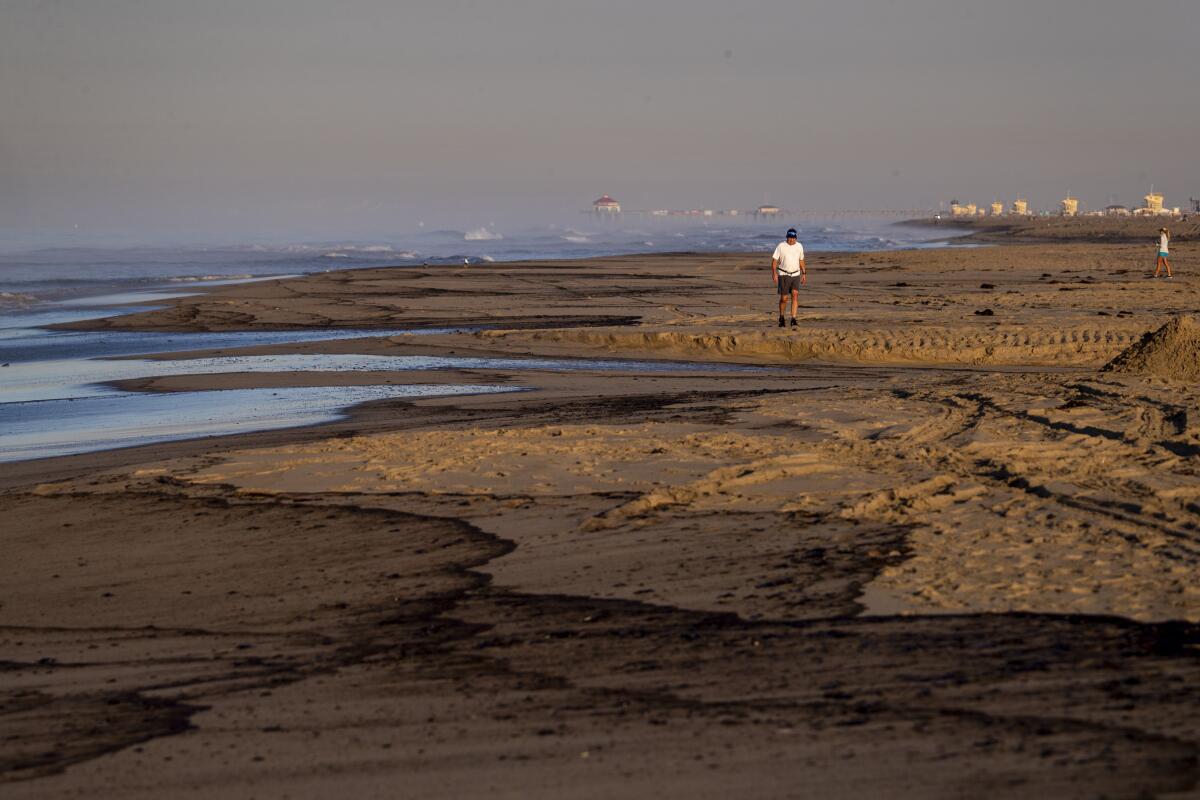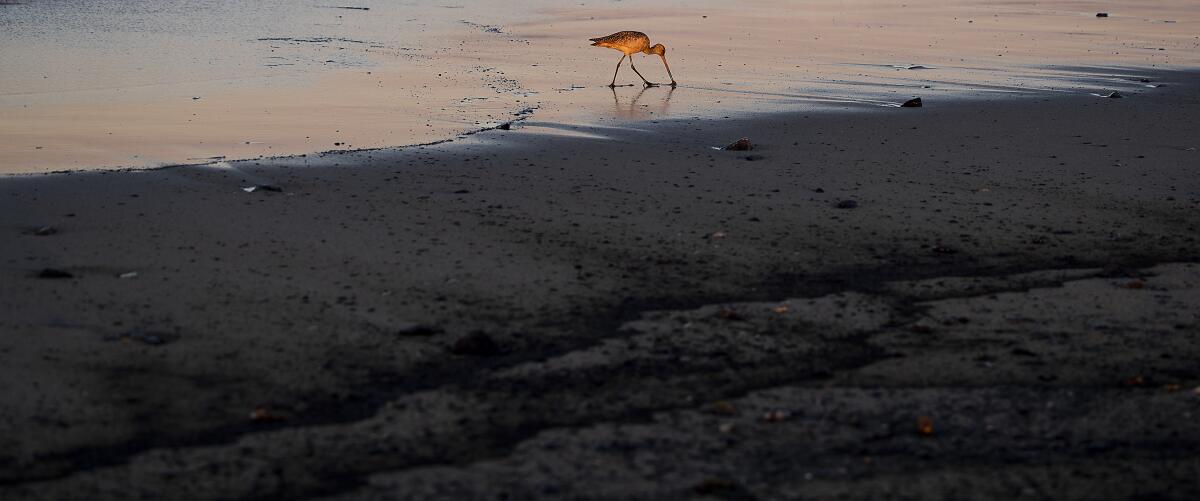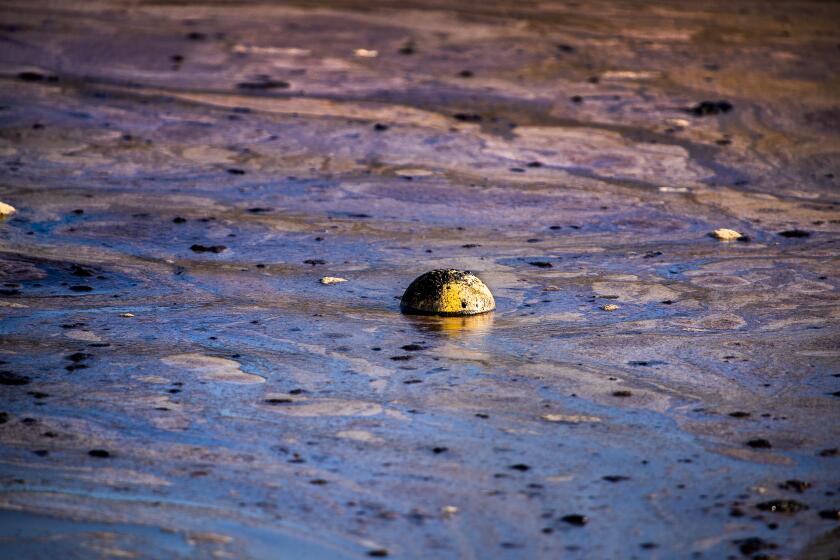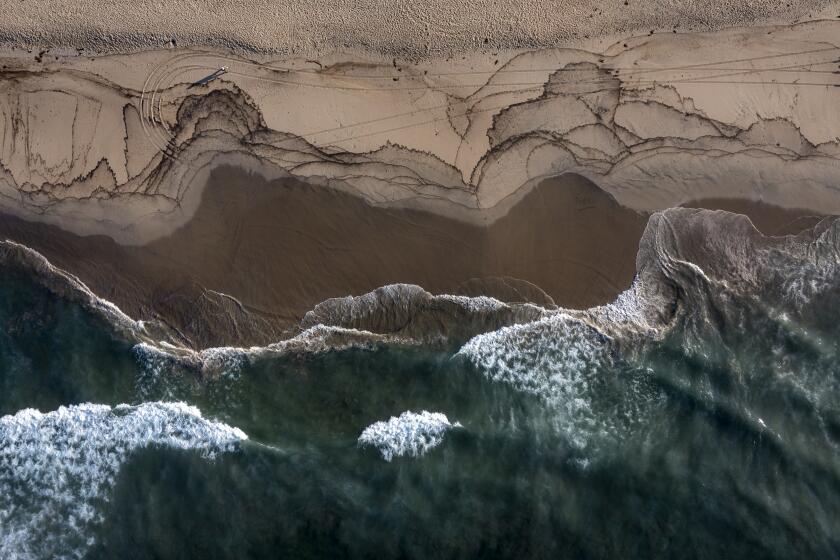Massive oil spill sends crude onto Orange County beaches, killing birds, marine life

An oil slick believed to have originated from a pipeline leak has hit Huntington Beach, closing a stretch of beach and raising grave wildlife and environmental concerns.
Crews raced Sunday morning to contain the damage from a major oil spill off the Orange County coast that left crude spoiling beaches, killing fish and birds and threatening local wetlands.
The oil slick, first reported Saturday, originated from a broken pipeline less than three miles off the coast of Huntington Beach connected to an offshore oil platform known as Elly. The rupture has poured more than 126,000 gallons of crude into coastal waters and seeped into the Talbert Marsh, officials said.

By sunrise Sunday, oil had washed ashore in Huntington Beach with slicks visible in the ocean, prompting officials to close a stretch of sand from the pier to the Newport Beach city line. Dead birds and fish had begun to wash up on the shore, officials said.
“We classify this as a major spill, and it is a high priority to us to mitigate any environmental concerns,” said Jennifer Carey, a Huntington Beach city spokesperson. “It’s all hands on deck.”
After sunrise the smell of diesel and tar overwhelmed the shoreline at Huntington State Beach. Crashing waves brought dark oil onto the shore in clumps and rings.
Orange County Supervisor Katrina Foley said a broken pipeline connected to an offshore oil platform called Elly caused the spill.
Despite the beach closure, residents walked out onto the sand early Sunday to observe the damage.
“It’s terrible,” said Jon Ely, a 58-year-old Huntington Beach resident. “This stuff is not going to come up. It’s goo, and it’s thick.”

U.S. Rep. Michelle Steel (CA-48), who represents several Orange County beach cities, sent a letter to President Joe Biden Sunday requesting a major disaster declaration for the county, which would make additional federal assistance available for state and local agencies and individuals impacted by the spill.
“It is imperative that the federal government assist in recovery efforts,” she wrote. “I have serious concerns about the environmental impacts of the spill and applaud the workers who are doing their best to prevent the oil from hitting sensitive wetlands.”
Huntington State Beach is home to a number of species of birds, including gulls, willet, elegant terns and reddish egret, which are a rarity on the west coast, according to Ben Smith, a biologist and environmental consultant for the county.
Smith drove to the beach Sunday morning to observe wildlife ahead of a construction project planned at the mouth of the Santa Ana River, which opens into the ocean at the border of Huntington State Beach and Newport Beach.
The oil spill off the Huntington Beach coast has prompted closures and safety advisories.
“There’s tar everywhere,” he said, surveying the birds congregated on the north bank of the river. “You think by now we would have figured out how to keep this kind of thing from happening, but I guess not.”
The spill could have a significant impact on the habitat, he said.
“If the birds get into this tar it’s going to stick to their feathers and it’s going to be a problem for them,” he said. “It contaminated the water — it’s bad for the wildlife, bad for the water, bad for the people who use the water. It’s really unfortunate.”
The spill has already resulted in more fuel being spilled in waters than one that occurred in San Francisco Bay in 2007, which involved the cargo ship Cosco Busan striking the San Francisco-Oakland Bay Bridge in heavy fog. That spill poured 58,000 gallons of bunker fuel into the bay, resulting in the documented deaths of more than 6,800 birds.
Orange County Supervisor Katrina Foley whose district includes Huntington Beach said oil was continuing to spill from the damaged pipeline through the night, but divers were working to repair it early Sunday.
Out on the beach early Sunday Foley said she watched as softball-sized clumps of oil washed up onto the sand.
“It’s a huge environmental impact and it’s an economic impact both in terms of the cleanup and shutting down a major tourist destination during a pandemic when we’ve all been struggling,” she said. “It’s a tragedy on all fronts.”
The good news, she said, is that technology has improved enough in recent years that officials can identify and mitigate the spread of the oil faster than in past spills. Floating barriers known as booms have been deployed to try to stop further incursion.
“We can get this cleaned up sooner and better than in prior oil spills, but that doesn’t mean it’s OK that this happened,” she said. “Someone has to be held accountable for how this happened.”
Areas just offshore from the Southern California coast are a major source of oil. The platform Elly, located in federal waters off the Los Angeles County coast, was installed in 1980 and processes crude oil production from two other platforms. Elly sits atop a large reservoir of crude oil that is called Beta Field, which sits in waters overseen by the U.S. Department of the Interior.
The spill has caused “significant ecological impacts” to the beach and wetlands area, Huntington Beach officials said.
The Pacific Marine Mammal Center in Laguna Beach is preparing to triage oiled wildlife impacted by the spill in the coming days, said Krysta Higuchi, public and community relations manager for the center. The amount of wildlife impacted by the spill is unclear.
“We’re not entirely sure of the magnitude just yet,” she said. “It’s definitely an all hands on deck kind of situation. We are trained for it, but it’s training you never want to have to use.”
The final day of the three-day Pacific Airshow, which had been scheduled for Sunday, has been canceled. The air show this year featured flyovers by the U.S. Navy Blue Angels, the U.S. Air Force Thunderbirds and the Canadian Forces Snowbirds.
“The need for prompt and intensive intervention efforts requires complete and unfettered access to the marine environment,” Huntington Beach officials said in a statement.
Officials said they had identified a 5.8-mile oil plume running roughly from Huntington Beach Pier to Newport Beach.
Newport Beach Mayor Brad Avery was sailing to the air show from Avalon on his boat about 11:30 a.m. Saturday when he came across the spill. Other boaters had reported it on the marine radio as they passed over the slick, he said.
“As we got within about five miles of the coastline all the sudden we were going through this major oil slick,” he said. “We had a pod of dolphins on our bow as we were going through it. Of course we couldn’t signal to them to change direction, but they seemed to make it through OK.”
The coast in Newport Beach remained open Sunday morning, but officials were starting to receive reports of oil hitting the beach between 52nd and the jetty, said Councilman Will O’Neill.
Early Sunday four men cast fishing lines in the water near the mouth of the Santa Ana River in Newport Beach where the sand remained open. Families hauled beach chairs across the sand to the water.
Newport Beach officials have stopped short of closing beaches, but are advising people to stay away from the beach and water.
“It’s not safe. Even as we’re standing here I can smell the fumes. The fumes are actually toxic and not safe to breathe,” Foley said. “If you swim or surf in the water that’s not good for your health — it could cause long term complications.”
The Coast Guard received an initial report of an oil sheen about three miles off the coast of Newport Beach about 9:10 a.m. Saturday. Huntington Beach city officials said they were notified of the spill about noon.
Workers moved to shut the pipeline down and use pressurized equipment to retrieve as much oil as possible soon after the incident was reported, said Kate Conrad of Beta Offshore, a Southern California oil producer involved in the operation.
“We were alerted quickly,” she said.
The Coast Guard has established a unified command along with Beta Offshore and California Department of Fish and Wildlife’s Office of Spill Prevention and Response.
People are being asked not to approach potentially affected wildlife, as “they can cause more harm than good to the animals,” but instead call the UC Davis Oiled Wildlife Care Network at (877) 823-6926, said Eric Laughlin, a spokesman for the California Department of Fish and Wildlife. A crew from the network has been mobilized for any needed rescue and rehabilitation work.
“Members of the public should avoid the oiled shoreline, as the area is unsafe and should be cleaned only by trained contractors,” Laughlin said.
Newport Beach resident Kerry Keating said she and other neighbors began smelling a “horrible and strong” tar-like odor Friday night, and several people on the Nextdoor neighborhood network also reported hearing a loud boom.
“We are all quite concerned for the marine life,” Keating wrote in an email.
Several residents surveying Newport Beach Sunday morning expressed skepticism about the timeline of the spill and the notifications they received.
Neal Shehab, a 61-year-old resident of Newport Shores, said he started to smell oil fumes as early as Friday night.
“We didn’t know what it was,” he said, adding that he believes the public wasn’t quickly notified because “they didn’t want to cancel the first day of the airshow.”
On Saturday, the second day of the Airshow proceeded. Residents posted on social media, wondering if the foul smell was a byproduct of exhaust from overhead planes. Officials cancelled the last day of the airshow on Sunday.
The event is thought to generate about $68.1 million in spending and $3.4 million in additional tourism-related revenue, according to a 2019 report on the economic impacts of the Great Pacific Airshow.
Hal Lopez came to town from the Bay Area to catch the Great Pacific Air Show, staying with relatives in Huntington Beach. Jogging along the packed boardwalk Friday evening, he remembers smelling something rotten—like old meat.
“I didn’t know what was going on and had to stop running, I have a very sensitive nose,” he said.
The gardener said that over dinner, his cousin told him that neighbors were talking about an oil spill. They logged online to read the City Hall website, searching for information to confirm or dispel rumors.
“Everyone was wondering about the local officials giving us a clue or some type of warning,” he said.
On Saturday night Huntington Beach fire officials deployed booms to block the ocean water from entering the Bolsa Chica Ecological Reserve and wetlands, said Carey, the city’s spokeswoman.
At a news conference late Saturday night, local officials expressed grave concern about the environmental impacts of the spill and hoped workers could prevent the oil from hitting sensitive wetlands.
“We’ve been working with our federal, state and county partners to mitigate the impact that could be a potential ecological disaster,” Huntington Beach Mayor Kim Carr told reporters.
The incident comes more than 30 years after a huge oil spill hit the Orange County coast.
On the afternoon of Feb. 7, 1990, the oil tanker American Trader ran over its anchor in relatively shallow water off Huntington Beach, spilling nearly 417,000 gallons of crude and fouling popular beaches along the Orange County coast. The oil killed fish and about 3,400 birds.
In 2015, an oil pipeline ruptured north of Santa Barbara and sent 143,000 gallons of crude oil flowing onto Refugio State Beach, with some of it getting into the ocean. Tar balls from the leak were found as far away as Manhattan Beach.
That spill forced the closure of Refugio and El Capitan state beaches and covered waves, rocky shores, sandy beaches and kelp forests with oil. According to the Oiled Wildlife Care Network, which was involved in recovery efforts, 204 birds and 106 marine mammals died as a result of the spill.
A Santa Barbara County grand jury later indicted Plains All American Pipeline on 46 criminal counts, including four felony charges of knowingly discharging a pollutant into state waters. The company agreed to pay more than $60 million and change its operations to settle litigation arising from the oil spill.
Sen. Dave Min (D-Irvine) said the Orange County spill is a catastrophe for the area’s beautiful coastline.
“I spoke with state officials last night, and this oil spill sounds comparable to the 2015 spill at Refugio State Beach. Beaches may have to be shut down for several weeks or longer. The impacts to our local marine ecosystem and economy will be significant,” Min said.
There has been debate in recent years about whether the government should allow new oil drilling off the California coast. No new offshore oil drilling has been approved in federal waters off the state coastline since 1984.
The Trump administration proposed to open for exploration offshore oil and natural gas reserves, including waters off California.
Sen. Dianne Feinstein (D-Calif.) proposed a bill in January that would permanently ban the Department of the Interior from allowing new leases to allow for the exploration, development or production of oil or natural gas off the coast of California, Oregon and Washington state.
“This oil spill is a tragic reminder that offshore drilling is a devastating threat to our coast and its wildlife,” said Miyoko Sakashita, director of the Center for Biological Diversity’s Oceans program. “I’ve seen the aging oil platforms off Huntington Beach up close, and I know it’s past time to decommission these time bombs. Even after fines and criminal charges, the oil industry is still spilling and leaking into California’s coastal waters because these companies just aren’t capable of operating safely.”
The worst marine oil spill in California’s history occurred in 1969, after a blowout of a drilling rig platform resulted in the spill of 4.2 million gallons of crude off Santa Barbara. Crude oil spewed out of the rupture at a rate of 1,000 gallons an hour for a month before it could be slowed; thousands of birds, fish and sea mammals died.
The 1969 offshore oil spill was the nation’s worst until the Exxon Valdez dumped 11 million gallons of crude oil off the coast of Alaska in 1989. That spill painted beaches black, and resulted in the corpses of seals and dolphins washing in with the tides.
The largest marine oil spill in U.S. history resulted in 134 million gallons of oil spewing into the Gulf of Mexico after an explosion in 2010 rocked the Deepwater Horizon drilling platform.
The San Francisco Bay Area recently commemorated the 50th anniversary of the devastating 1971 oil spill that dumped 800,000 gallons of bunker fuel in the bay. The spill occurred after two oil tankers struck each other in heavy fog. Thousands of birds died.
All the latest on Orange County from Orange County.
Get our free TimesOC newsletter.
You may occasionally receive promotional content from the Daily Pilot.












